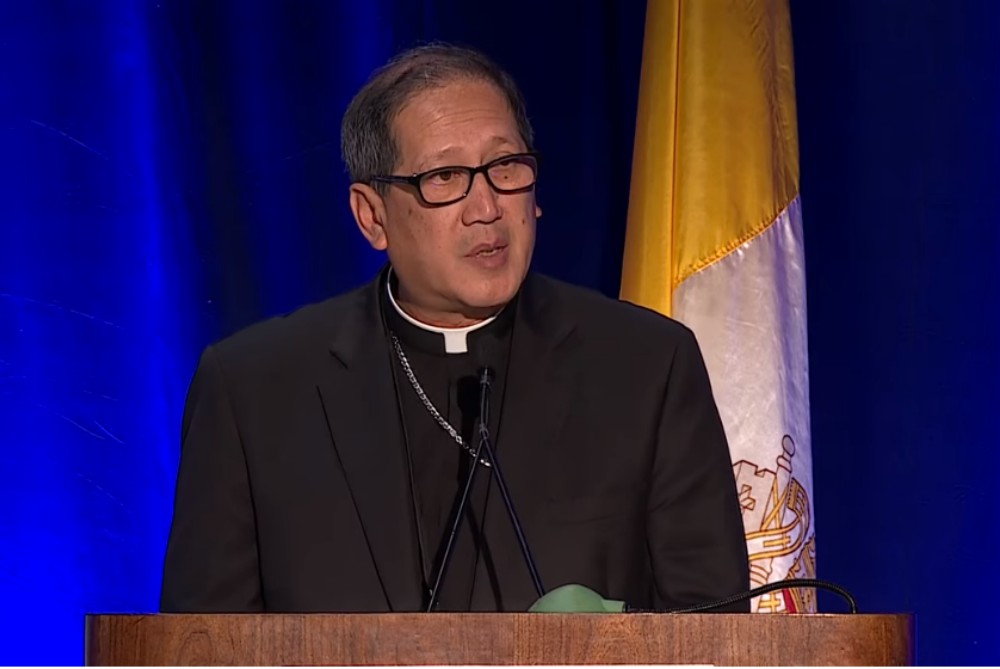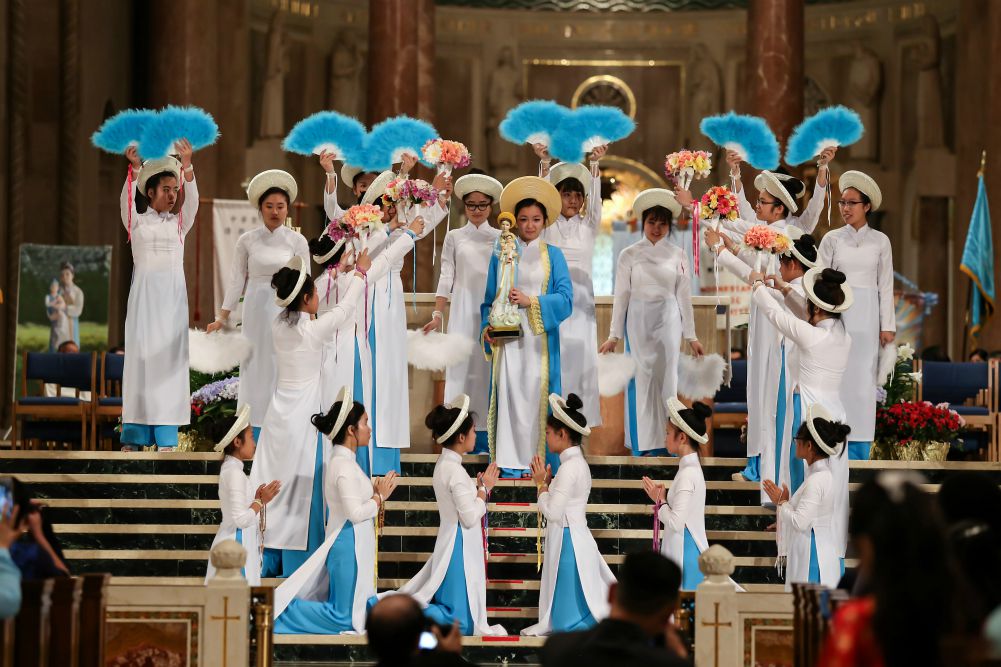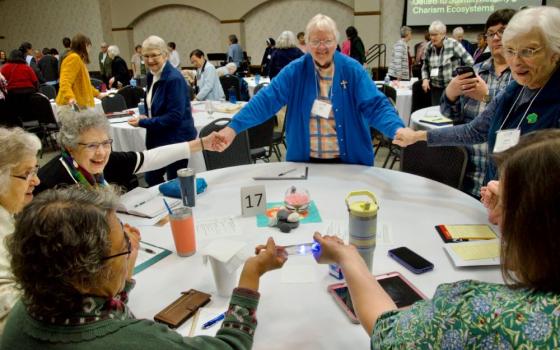
Bishop Oscar Solis speaks at the June assembly of the U.S. Conference of Catholic Bishops. (Leticia Rivera)
Bishop Oscar Solis of Salt Lake City, Utah, is not a stranger to the immigrant communities in the United States.
"I was an immigrant myself and was naturalized a U.S. citizen in 1999," he said in an interview with NCR. "I worked in Los Angeles with different immigrant groups. Now as bishop I am serving Hispanics and Latinos, which comprise half of the Catholic population in Utah."
Born in 1953 in the Philippines, Solis said he received great support from his parents to pursue his priestly vocation. He was ordained in 1979 and served the diocese in education and seminary formation. In 1984, he was scheduled to go to Rome to study canon law, but ended up as an associate pastor at St. Rocco's Church in the Archdiocese of Newark, New Jersey. He transferred to the Diocese of Houma-Thibodaux, Louisiana, in 1988 and served in parochial ministries until Dec. 11, 2003, when he was appointed auxiliary bishop of Los Angeles Archdiocese.
In Los Angeles, he not only served as director of the Office of Justice and Peace, but also served as director of Ethnic Ministry, ministering to people of about 40 language groups, and as an archdiocesan liaison in carrying out the Campaign for Immigration Reform. On Jan. 10, 2017, he was appointed the 10th bishop of Salt Lake City.
At a national level, he is the chairperson of the Subcommittee on Asian and Pacific Island Affairs of the U.S. Conference of Catholic Bishops. He is also a member of the standing Committee on Cultural Diversity in the Church.
It was at the spring general assembly that Solis presented to the U.S. bishops "Encountering Christ in Harmony: A Pastoral Response to Our Asian and Pacific Island Brothers and Sisters." The bishops approved the document, which outlines the pastoral needs of Asian and Pacific Islander communities and provides a framework for dioceses and parishes.
In an interview, Solis talked with NCR about the significance of this document and how it could enrich the U.S. church in dialogue with culture. The interview has been edited for clarity.
"The time is ripe for an organized national pastoral approach to ministry with the diverse and growing Asian and Pacific Island communities."
—Bishop Oscar Solis
NCR: What do you see as the significance of this document?
Solis: It is a very important document as it recognizes the presence of the Asian and Pacific Island communities as an integral part of the Catholic Church in the United States. Asians and Pacific Islanders are the fastest growing minority population. They comprise the third largest segment of the U.S. Catholic population. They are ready for pastoral engagement in the church's mission of evangelization as well as sharing their precious cultural gifts of strong faith, rich cultural values and colorful traditions.
The diversity in language, customs and traditions enriches and at the same time challenges the U.S. Catholic Church in the pastoral care of the Asian and Pacific Island communities. They need pastoral guidance and support for their full integration and communion in the church, as well as formation, so that they develop to become effective leaders and missionaries of Christ. In many cases, they are producing vocations in the church at a larger ratio than their share of the Catholic population.
With this reality, the time is ripe for an organized national pastoral approach to ministry with the diverse and growing Asian and Pacific Island communities.
Advertisement
Could you talk a little about the background of this pastoral response?
One significant feature of this document is that it refers to the call of Pope Francis to the church's mission of encounter and engagement with cultures, recognizing that in the encounter with Christ, culture is transformed by the power of the Gospel.
The reason we termed this document as a pastoral response instead of a pastoral plan is that pastoral plan identifies goals, objectives, actions and metrics, within a determined period of time. However, because of the broad cultural diversity among the Asians and Pacific Islanders and their presence so spread out across the nation, with specific needs and issues, it will be very difficult to put up one plan that fits all. Pastoral response is a better option, as it offers a framework for dioceses and parishes to help them integrate these approaches. They can have the "free hand" to create their own pastoral plans or actions specific to the circumstances and needs of their local Asian and Pacific Island communities.
In regard to the background of this document, this pastoral response is the result of the unique collaboration between the Subcommittee on Asian and Pacific Affairs, Asian and Pacific Catholic leaders and others. The information contained in the document is the product of a laborious and expansive in-depth study of Asian and Pacific Island Catholics in the United States today. One example on cultural information, the document describes "harmony" as a common theme in many Asian and Pacific Island communities. The term harmony expresses the openness to encountering the Lord through their cultural understanding of unity in diversity. The document also provides current information, renewed awareness, continuing education and formation. Its intentional approach is to cultivate the missionary efforts to Asian and Pacific Island communities with new ardor and methods.
As an Asian-American bishop, how would this document assist API (Asian and Pacific Island) communities?
This pastoral response will help advance the church's mission of evangelization to the Asian and Pacific Island communities. Not only will it assist dioceses, parish leaders and other Catholic entities and the faithful in welcoming and integrating Asian and Pacific Island Catholics, it also recommends pastoral approaches. It provides resources and information about Asian and Pacific Island Catholics. Finally, it promotes collaboration among pastoral leaders in strengthening unity in diversity, integration and communion.

Members of the Asian and Pacific Island Catholic communities display their culture and faith at the Basilica of the National Shrine of the Immaculate Conception in Washington May 5. (CNS/Brian Searby)
Is this pastoral response a landmark for API communities?
Definitely. The document gives a strong message — a collegial voice and effort of the U.S. Catholic bishops in the pastoral outreach to Asian and Pacific Island communities. This is the first official document issued by this body of U.S. bishops since 2001 about the growing Asian and Pacific Island communities. It has the collegial approval by the body of bishops, indicative of intentional pastoral outreach and as essential part of the mission of the church.
We see this document as a response to Pope Francis' call to go to the peripheries to proclaim the Gospel. Through this pastoral response, our church is not only going out to the peripheries, but we are bringing the peripheries for closer integration and fuller communion with the church, the Body of Christ.
[Peter Tran is currently the assistant director of the Redemptorist Renewal Center in Tucson, Arizona. He is a former editor of the Union of Catholic Asian News at the main editorial office in Bangkok. During his years as a Redemptorist, his ministry was extensively in the field of pastoral care for refugees and migrants in the United States and at the Vatican.]





